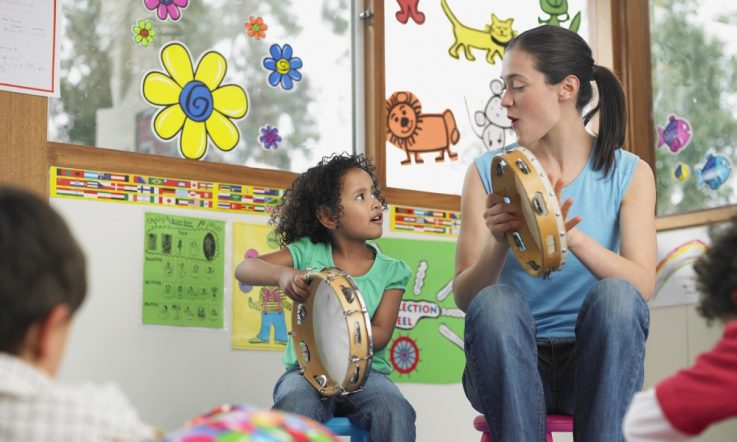Developing targeted school programs to meet individual learning needs includes making the best use of staff (and sometimes community) expertise, and working closely with parents.
Some 83 per cent of the 836 enrolments at Newbury Primary School in the Melbourne suburb of Craigieburn have a language background other than English. Among the school's families, 33 different languages are spoken at home. In the past 12 months alone, the school has enrolled 46 refugees and 20 new arrival children.
How would a new school support the learning needs of so many children with English as an Additional Language (EAL)?
The P-6 government school decided to move away from the traditional withdrawal model. Principal Michelle Bromfield's vision was for all but the very high needs EAL learners to be supported in the general classroom.
EAL Support and Intervention Leader Kate Plant was tasked with the job of making this happen. Plant has been at the school since its inception in 2017 and set up the program. She and an interpreter meet all families in preparation for the enrolment of any new children.
‘We meet with all new arrival families to do a sociolinguistic profile to gather as much information as we can prior to the children starting,' Plant tells Teacher.
‘That provides me with information so that I can give a narrative about the family and their background to the classroom teacher and specialist classes. The information includes where they were born, their journey to Australia, if there was any trauma involved, age and siblings or if they have any family here for support in Australia. We also get information on dietary requirements, medical issues – more information than the tick box on the enrolment form.'
They also find out about the child's history with schooling and any interruptions they may have experienced. ‘For example, some children have very interrupted schooling, if any schooling at all, or they may have had schooling in English or schooling in their home language,' Plant explains.
Placing wellbeing at the forefront
She says all this additional information enables staff to cater for the children holistically. ‘Wellbeing is at the forefront of everything we do at Newbury. For example, we have had some students that have been scared of the bell due to [an historical association with] bombs. Some children have trouble with all the space they have at recess and lunch, especially if they were in small camps for a long time.'
Plant says one question always stands out and promotes discussion: ‘Is there something that might affect your child's learning or happiness at school?'
All teachers, including specialists, have access to relevant family background and Plant does not hesitate to link the families with external agencies when required.
‘Our EAL program aligns very well within the Calmer Classrooms approach, as it allows teachers to work with the understanding of how the integration of attachment theory, trauma theory and child development theory work to develop teaching practices that develop positive relationship-based skills to maintain a positive attachment to school.'
Staff at the school have completed much professional learning in the last three years and Plant is personally working through the Certificate IV in TESOL (Teaching English To Speakers of Other Languages). Much of the practice at the school is based on the work of Dr Pauline Gibbons (2014).
A three-tiered approach
‘We work with the three-tiered approach. The top tier of students is the top 5 per cent with the highest EAL needs, and I work with them in small group intervention; the middle tier is the next 15 per cent of highest EAL needs, language experience is the focus (promoting reading and writing through the use of experience and oral language), and I work with them each week, [though] less time is allocated; and the bottom tier is the rest of the 80 per cent of students that are catered for in the classroom.
‘The teachers use EAL strategies in the classroom to support all students, because we know that strategies for EAL students benefit all learners.' In contrast, Plant adds all teaching strategies in general do not support all EAL learners.
At the beginning of each year, each classroom teacher gets an overview of the middle and top tier students who will be in their class – both academic need and background. ‘We also have an EAL support teacher that works with teachers in the classroom supporting these students and upskilling the teachers.
‘Our biggest message [to teachers] is to scaffold their learning, not to “dumb” it down,' Plant says. ‘Scaffolding through each stage of their learning and tasks for the biggest impact for learning. Lots of collaborative and partner work is also encouraged.
‘All of what the teacher does incorporates visuals to support learning and reduce cognitive load in the classroom. We work from using language as an exploration to language as performance.'
Language and vocabulary
To support students with new vocabulary, each classroom has basic ‘survival language' posters that look the same; for example, there are pictures of a drink bottle, toilet, food, along with pictures of children sitting on the floor in a group and children sitting at the table.
‘Developing their oral language and vocabulary is always at the forefront of our planning. Lots of conversation and … explicitly teaching and exploring the vocabulary associated with what they are learning at the time.'
Plant says this includes: Prioritising parts of the text, the most important parts of information; Connecting – making connections to real life, past experience and even first language; and Speaking – encouraging a lot of discussion, and modifying, facilitating, repeating and multiple exposures.
Aside from the expertise of Newbury staff, Plant says the EAL support and intervention program requires a much wider collaborative effort. ‘In order for this to be a success, we work closely with the English Language School, Foundation House (a Victorian non-profit organisation working with those from refugee backgrounds who have experienced torture and trauma) and the interpreting service. We have a passionate staff that are all willing to learn.'
A classroom example
Plant says the middle tier program uses a language experience approach. Here, she gives an example from the classroom.
To make connections to prior knowledge, EAL support students revisited their work on ‘The Farm' to revise known vocabulary and connect it to new vocabulary. Reinforcing and developing oral language and vocabulary, with the help of scaffolding, will help prepare them for the shared experience.
In this case, one of the phrases was ‘a grain of wheat'. They were able to make links and use their new vocabulary in discussing a simple flowchart showing how the wheat is cut down, made into flour, used for dough, and to bake bread.
In the shared experience, students made their own bread. Photos were taken at different stages of the process (washing hands; putting flour in the bowl; putting water in the bowl …). From these photos arranged in the correct order, teachers and students created the text, discussing each photo with vocabulary used throughout the shared experience.
Each photo had a sentence attached, written by the teacher, that came from the students. Each student re-read the sentence after it was modelled. Plant says this technique helps the children understand the relationship between speaking, writing and reading.
References
Gibbons, P. (2014). Scaffolding language, scaffolding learning: Teaching English Language Learners in the Mainstream Classroom (2nd ed.).. Portsmouth, NH: Heinemann.
Kate Plant says a question to families that always prompts discussion is: ‘Is there something that might affect your child’s learning or happiness at school?’
Think about your own school context. What discussions would you like to have with new students and families, and what information would you like to collect, that would assist you as a classroom teacher? Who would you need to work with in the school or community to make this happen?



